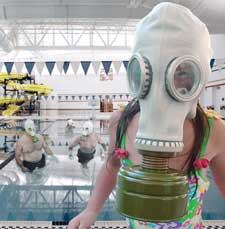The high school swim team was the first to notice. After practice, a handful of athletes would leave the pool coughing like smokers, their eyes red and noses swelling. Other swimmers suffered from dizzy spells, skin rashes, eye and nose irritations, and tight chests. The asthmatics in the group had it even worse, heaving and wheezing their way into the locker rooms. And their numbers seemed to be growing.
“Usually, we’d see one or two cases a year of kids with asthma,” says Dennis Majewski, director of district services at the Franklin Regional School District in Murrysville, Pa. “But we started seeing students who have no historical medical problems get irritations.”
Majewski carefully monitored the HVAC system and chlorine levels, but they remained within accepted parameters. Finally, he and his staff discovered the problem: The chlorine byproducts were making the swimmers sick. More precisely, they were making the air sick.
The main culprit, chloramines, are known asthma attack triggers. The higher the chloramine level, the more severe the attack. While Majewski and other aquatics professionals might be surprised that indoor aquatic environments can cause such health problems, scientists are not. Research has long suggested that prolonged exposure to chlorine byproducts can damage the lungs, which makes children and adults more susceptible to a host of respiratory illnesses. Chief among them is asthma, which shot up 160 percent between 1980 and 1994. Since then, rates have stabilized, but continue to climb.
While no one is solely blaming indoor pool environs, new studies are making the link to asthma and other respiratory illnesses difficult to deny. A controversial new Belgian study correlates high asthma rates with high numbers of indoor aquatics facilities. Meanwhile, new trends in aquatics design, everything from spraypads to energy-saving air systems, are only exacerbating the problem.
Indeed, indoor air quality issues have attracted the attention of the Centers for Disease Control in Atlanta. It is in the midst of a major study into the use of UV to control chloramines and improve air quality. Michael Beach, the CDC aquatics guru leading the fight against recreational water illnesses, calls air quality the next big issue for the aquatics industry.
It’s easy to see why. Connections between aquatic environments and respiratory illness could saddle indoor facilities with unhealthy reputations and set off a new round of lawsuits, warn experts. That, in turn, could hobble the growing aquatic exercise and therapy market, and the burgeoning waterpark resort industry. To avoid that fate, experts say, operators must recognize the problem and diffuse it or risk an industrywide air quality problem of epidemic proportions.
The diagnosis
In general, more children under age 5 are developing asthma every year. Out of 20 million Americans who suffer from this condition, 9 million are under age 18, according to the CDC’s National Center for Health Statistics. Scientists say lung damage can occur if children and adults are exposed regularly to disinfectant byproducts for long periods. And a number of studies show that young asthmatics who started swimming indoors are more likely to develop symptoms than those who swim outdoors or not at all.
In 1998, researchers at the National Jewish Medical and Research Center in Denver concluded that spray features, which created an aerosol of chlorinated water and byproducts, caused people to develop granulomatous lung disease, which they dubbed “lifeguard lung.” This disease also is caused by exposure to bacteria in inadequately ventilated air for long periods of time.
Mostly recently, a study at the Catholic University of Louvain in Brussels, Belgium, released in July found that for every extra pools per 100,000 inhabitants, European asthma rates increased by 2.7 percent in children 13-14; for 6- to 7-year-olds, rates increased 1.5 percent. “Trichloramine accumulating in the air of indoor swimming pools is one of the most concentrated lung toxicants to which children of developed countries are regularly exposed,” the study stated.
A similar study in Sweden examined the blood levels of a lung-specific protein called Clara cell protein, which protects the lungs. Those who went to indoor pools more often had significantly lower levels of Clara cells than those who did not.
Still, some doctors say this link is hardly conclusive. “I have not seen any harmful or negative effects [from swimming],” says Dr. Clifford Bassett, medical director at Allergy and Asthma Care of New York. “My opinion is based upon accumulated clinical data that swimming is generally a good thing and beneficial to most people with asthma.”
Others agree. “It’s highly unlikely that the rise [in asthma] we see across all industrialized countries is simply related to the presence of chlorinated swimming pools,” says Dr. Norman H. Edelman, chief medical officer of the American Lung Association in New York.
Jeff Sloan of the Chlorine Chemistry Council questions the measurement of the indoor air quality in the studies. “They don’t know what the kids were actually exposed to,” says the director of disinfection issues for the Arlington, Va.-based CCC. “Chlorine has been used for hundreds of years, safely and properly.”
But prominent aquatics experts admit the industry has a problem. “It’s very clear there’s a definite link between chronic chloramines and respiratory illnesses,” says Tom Griffiths, Ed.D., director of aquatics and safety officer for athletics at Penn State University in University Park, Pa. He calls air quality the “next new wave of litigation against facility operators.”
The cause
To understand why — and how to head off that wave — operators must first understand the relationship between air and water quality. As chlorine sanitizes, it creates an invisible vapor cloud of disinfection byproducts over the water. Concentrations depend on temperature, amount of chlorine, pH levels and air circulation.
When patrons complain of an overwhelming chlorine odor commonly referred to as the “pool smell,” what they’re really inhaling are chloramines, experts say. Chloramines result from chlorine killing off bacteria, and viruses and reacting with the ammonia found in sweat, urine and saliva. This process creates three types of chloramines: monochloramines, dichloramines and nitrogen trichloride, also known as trichloramines.
Another sanitization byproduct is trihalomethane, which in great amounts, can cause dizziness and respiratory issues. One common form of THM is chloroform, once used as an anesthetic by doctors. Studies with laboratory animals have shown that ingesting large amounts of THM can cause damage to the liver, kidneys and central nervous system. THM is a human carcinogen and may cause cancer if exposure happens regularly and for a prolonged period of time. According to the CDC, breathing 900 ppm can cause dizziness, fatigue and headaches. A typical natatorium contains up to .13 ppm; ambient air contains up to .00005 ppm.
Haloacetic acids form another sanitization byproduct that, when ingested in large quantities, can cause cancer in lab animals, though it has not been determined if it will affect humans. And it would be hard for someone to even know because these byproducts cause damage slowly over time, says June M. Weintraub, Sc.D., senior epidemiologist at the San Francisco Department of Public Health.
While damage may be prevalent in some, individual sensitivities vary. “Some might not notice there’s a chemical odor … but chemical odors can be problematic for others,” says Mike Tringale, director of communications at the Asthma and Allergy Foundation of America in Washington, D.C. “You can have a huge Olympic stadium vs. a hotel pool and get different outcomes.”
Further chlorination at higher levels can eliminate these odors, but other methods — ventilation, filtration and UV systems — exist to get rid of them. The problem, however, is that many facilities don’t apply these methods, experts say. As a result, patrons and staff constantly breathe in noxious fumes, sometimes with debilitating results.
At the same time, Griffiths says more cases of respiratory illnesses and asthma are occurring because more users are in the pool. He attributes the growth to the popularity of aquatic exercise, masters swimming and swim lessons for kids. Coaches are drilling swim teams to put in more mileage, extending their time in the pool and producing more sweat. The ammonia from the sweat binds with chlorine to produce chloramines. Griffiths personally receives more phone calls and written correspondence regarding chloramine problems from facilities around the country. In fact, he says he’s received “more this year than my entire career here.”
In addition, as traditional pools evolve into leisure pools, they offer more hours of sliding, splashing and spraying. This translates into more hours of chloramine exposure in the form of vapor hovering above the pool and in the fine aerosol that sprays from water cannons, jets and waterfalls. Meanwhile, the indoor waterpark has become a rising star, where children and families while away entire weekends for hours on end.
“We’re changing the types of pools we have to ones that spray and agitate — from waterfalls to pop jets to hydrotherapy jets that just aerosolize [chloramines],” says Alison Osinski, Ph.D., president of Aquatic Consulting Services in San Diego. “We’re putting it in a form that’s easier to breathe.”
What’s also happening, she says, is that while more chloramines are filling the air, less fresh air is being exchanged. As facilities adopt more energy-efficient ventilation systems, the bad air is being recirculated to conserve heating costs. “In an attempt to be energy efficient, we’ve caused a problem in the natatorium,” she says. “We really didn’t have this problem 30 years ago. But we also had very energy-inefficient air handling systems.”
Griffiths blames energy-efficient systems for the heightened chloramine levels, too. “The pools with the best air quality will be the worst in terms of energy conservation,” he says.
In addition, many water supply companies now are using monochloramines to treat tap water. Because chlorine creates carcinogenic byproducts even though levels are strictly regulated by the Environmental Protection Agency, some areas have switched to disinfection that uses monochloramines. Unlike chlorine, monochloramines work slower, react with organic matter less often, and create fewer carcinogens in drinking water.
When fresh water is added to pools, the chloramine levels rise. In Majewski’s case, his chloramine levels were at 2.8 ppm, and he was fighting to lower them to 2.2 ppm. “We had 10 times the chloramines coming into the water than we were trying to maintain,” he says.
Some experts say breakpoint chlorination will reduce those levels, while others say it is impossible to shock a pool that often. In the pool, monochloramines will react to form dichloramines and nitrogen dichloride to produce the pool smell unless further chlorine is added, says Tom Lachocki, CEO of the National Swimming Pool Foundation in Colorado Springs, Colo. Because indoor pools can require up to a daily dose of fresh water, pools may need to be shocked daily as well, at 10 times the chloramine level.
The prescription
The problem is not easily solved, but there are some simple ways to bring down chloramine levels.
In its first International Recreational Water Guidelines, the World Health Organization of Geneva, Switzerland, recommends 10 liters of fresh air per second per square meter of water surface area in indoor swimming arenas. Many U.S. codes require only about 15 percent air turnover, whereas Osinski says a system should never exchange less than 40 percent fresh air. “One hundred percent fresh air is what we want,” she says. Higher rates of exchange are healthier, but more expensive.
A second method, also costly up front, is the installation of an ultraviolet system to zap chloramines. Systems cost approximately $30,000 to purchase and install, and $3,000 annual operating costs. But that price seems worth it to those who have tried it. Majewski has joined that camp. Since installing his UV system chloramine levels have never risen above 2 ppm. “It seemed too good to be true,” Majewski says. “But we monitor it every day.”
The swimmers at Lawrence Indoor Aquatic Center in Lawrence, Kan., also have been enjoying an odor-free pool for the past four years. “We were seeing a higher incidence of some respiratory distress,” says Jimmy Gibbs, aquatics manager. “We still have to have chlorine, but [the system] allowed us to put a significantly less amount.”
While all of the evidence so far is anecdotal, the CDC is working on a study to determine just how much UV systems can reduce chloramines. The results should be ready by the beginning of 2007, says Beach, who is team leader, water and environment activity, Division of Parasitic Diseases at the CDC.
Maintaining a proper pH level is another key way to minimize nitrogen trichloride formation. Nitrogen trichloride is formed when the water is more acidic, while monochloramines thrive in more alkaline water levels.
Installing and maintaining a thorough filtration system also will help improve air quality. Granular active carbon lowers chloramine levels and removes other compounds such as THM. Adding zeolite to filter mediums will retain ammonia in the tank, Griffiths says.
In addition, educating patrons about pool air quality and how they can take responsibility in its improvement can eliminate a large part of the problem. Explaining why showering beforehand is essential and enforcing it will send the message. Pool managers can form a working relationship with asthmatic swimmers who fear the air quality would be more detrimental to their health. “Managers have a responsibility to talk to members and have a plan if there are problems,” Tringale says.
Other experts say managers should encourage asthmatic patrons to talk to their doctors about what their potential triggers may be, and future studies should consider the same questions. “The critical components here are the timing,” says Mark Nieuwenhuijsen, Ph.D., reader in environmental epidemiology at the Imperial College in London. “Does swimming come before the onset of asthma or vice versa? And the exposure assessment — what is the level of the contaminants?”
Tringale agrees. “[Asthma is] a custom-made disease. It really all depends on the person and the particular pool environment,” he says. “We encourage swimmers and parents of swimmers to talk to their doctors about better identifying what their triggers are.”
Operators should protect their staffs, too. Gibbs maintains close communication with his lifeguards and instructors to ensure they stay healthy on the job. “We take it very seriously,” he says. “If anybody feels something is wrong, we’ll do what we can to investigate it.” One suggestion: Rotate them regularly and encourage them to take a walk outside for fresh air. Sometimes staff members are the best measures for indoor air quality.
Finally, let the community know how safe and beneficial the pool can be, and the steps being taken to ensure excellent air quality. Lawrence Indoor Aquatic Center’s UV system made the local news, reinforced its positive image and, as word spread, other operators called Gibbs for information. Most importantly, the reassurance brought swimmers back.
“People want to feel safe,” Gibbs says. “They are more aware of their environments than they were in the past, and more people are sensitive about chemicals now.”



